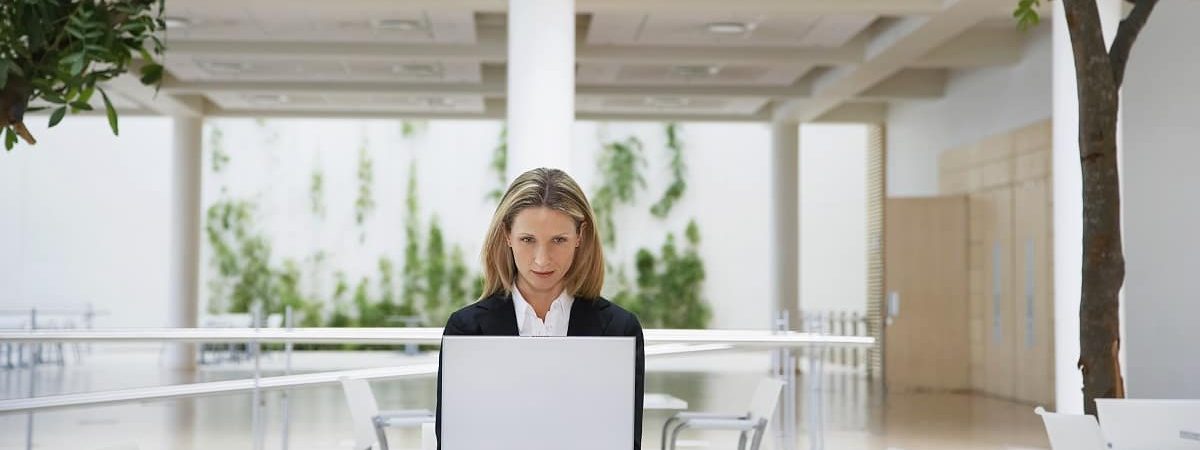
DESIGNING A HEALTHY WORKSPACE
The emphasis on health and wellbeing in the workplace is increasing. It is apparent that a healthier worker is more likely to be a happy worker and, in turn, a more productive worker. Prevention is better than cure; designing a workplace that minimises potential health risks is a great place to start.
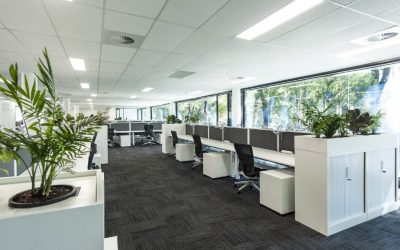
Time To Stand Up
In a typical working week people spend on average 5 hours and 41 minutes per day sitting at their desk (1). Combined with the amount of time spent sitting at home, when going out and sitting getting to and from work, it has been estimated that people are spending up to 10 hours per day on their backsides.
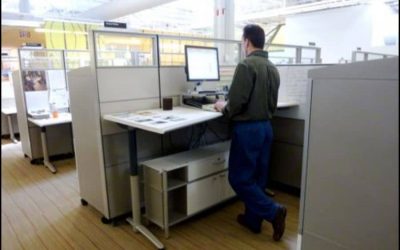
According to a study (2) in the American Journal of Epidemiology, sitting for more than six hours a day can increase the risk metabolic disease, obesity, cardiovascular disease, diabetes, stroke and various types of cancer.
The use of standing desks to overcome this potential health risk is outlined in the TKO blog “Standing for Better Health”.
Further reduction in the amount of time spent sitting in the workplace can be facilitated by:
Standing meetings – groups that stood up during meetings had significantly decreased territorial behaviour and increased sharing of information and ideas.
Standing meals – height adjustable tables or elevated tables/benches can be used to facilitate standing meals and/or discussions.
Counselling/discussions while walking – not necessarily a workplace design element; one-on-one walking discussions are used by some managers to provide exercise, get some fresh air and increase exposure to sunlight.
Maximum Use of Natural Light
In addition to making employees feel more energised during the day, exposure to natural light has significant benefits for workers’ health and wellbeing.
A study (3) conducted by researchers from Northwestern Medicine and the University of Illinois found that office workers with windows at the workplace had more light exposure during the workweek, a trend toward more physical activity and longer sleep duration. (Those with windows in the workplace soaked up 173% more white light exposure during the day, and slept an average of 46 minutes longer per night than workers with less exposure.)
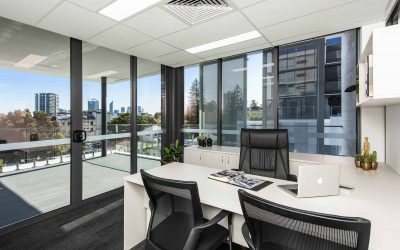
The researchers suggested that a design solution to provide suitable levels of natural light would be to make sure workstations are within 20 to 25 feet (approximately 6 to 7.6 m) of the walls containing the external windows.
A Green Office is a Productive Office
The research showed plants in the office significantly increased workplace satisfaction, self-reported levels of concentration, and perceived air quality.
Going further than just plants throughout the workplace, the use of green (vertical) gardens was highlighted in TKO blog “Living Walls Transform Green Interiors”.
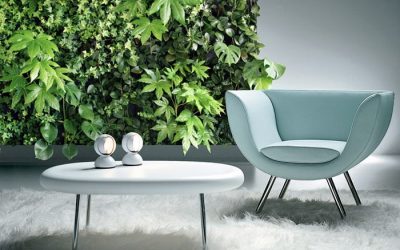
According to former University of Guelph researcher Dr Alan Darlington, the incorporation of green walls are drastically increasingly Indoor Environmental Quality (IEQ) passively, without reliance on energy:
“We’re getting rid of 60 to 70 per cent of the pollutants in the air after a single pass through the filtration system,” he said. “It means less fresh outdoor air has to be brought in to maintain air quality and that significantly reduces the energy required to heat or cool the air. It’s a really beautiful technology.”
Provide Quiet Areas
The open plan office has become the norm since the early 1990s. Although an open plan office hypothetically allows for increased worker interaction and communication leading to increased productivity, some studies have found this not to be the case (5).
Issues with open place offices include the lack of privacy and the inability to conduct discussions or make phone calls without disturbing other workers.
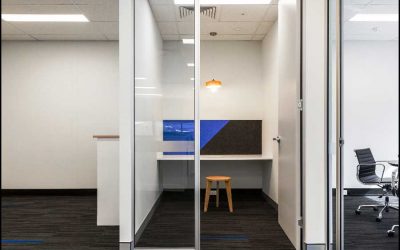
Some research claims open plan offices are healthier than workplaces comprising of private offices; however, the majority of studies found that open plan workplaces can make workers unwell both physically and psychologically. The reasons for this include environmental stresses (including being exposed to ‘irrelevant sound’, the lack of ‘visual privacy’ and a reduced ability to control one’s own personal space), as well as the risk of infection, the types of jobs done in open-plan offices and group dynamics might all play a part (6).
According to former University of Guelph researcher Dr Alan Darlington, the incorporation of green walls are drastically increasingly Indoor Environmental Quality (IEQ) passively, without reliance on energy.
Designing a healthier open plan workplace could include the following:
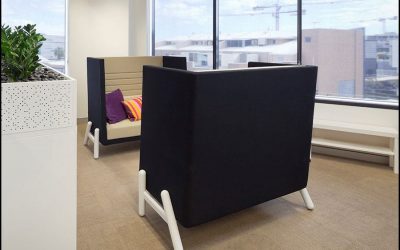
- Break out areas for both formal and informal group interactions – see TKO blog: The Rise of the Social Breakout Zone in Office Design.
- Quiet or sound proofed rooms for phone calls or one-on-one discussions – as usual, Google have taken this concept to an extreme. Details and photos here.
- Maximum use of noise attenuating materials such as acoustic panels, sound check plasterboard etc
- Use portable technology – the use of laptops rather than fixed computer monitors will mean workers are not tied to a desk and can work in a quiet room, break out area or from home if required.
Ergonomic Furniture
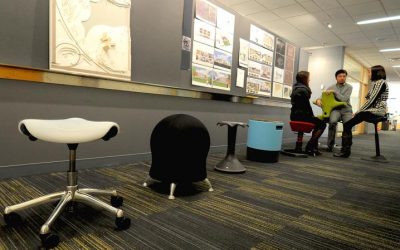
Even if design changes and health initiatives have encouraged some workers to spend less time sitting down, there will still be a certain number of people still spending a large percentage of their workday sitting in their chairs. Regardless of the total amount of time each employee spends sitting down, it is incumbent upon business owners to ensure that workplace furniture is as comfortable and healthy as realistically possible.
A TKO blog article highlighted some of the best alternatives to the traditional desk chair.
Some of these ergonomic chairs make seem a bit extreme in a traditional workplace; comfortable seating that supports back health may be a suitable option.
Colours in the Workplace
The use of different colours throughout the workplace can impact worker mood, productivity and overall wellbeing (7).
Different colours definitely produce different effects. However, there are a number of contradictory reports on the effect different colours have on workers.
Yellow is said to be the colour of optimism and creativity, yet is also said to become draining (8). Red can be stimulating and ideal in activating passion, yet can also generate anger (9).
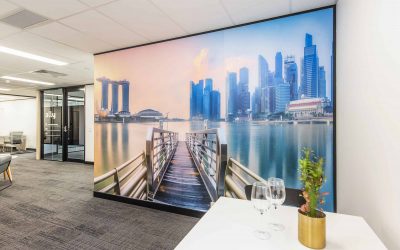
Nature based colours such as blues and greens are consistent favourites. Blue is considered calming and an aid to creative thinking. Green is said to promote thinking and provide an invigorating energy (8).
There is no correct choice of colour for a workplace environment. A dull space will exhaust employees, yet vivid colours can distract and distress (9). The best results will be achieved through balance. Essentially, it is about producing a setting to suit your business and value your visitors, as well as inducing an optimistic and inspiring atmosphere for your employees (8).
References
(1) https://www.sciencedaily.com/releases/2012/01/120113210203.htm
(2) Patel, Alpha V. et al. 2010. “Leisure Time Spent Sitting in Relation to Total Morality in a Prospective Cohort of US Adults”. http://aje.oxfordjournals.org/content/172/4/419.full.pdf+html
(3) https://www.ncbi.nlm.nih.gov/pmc/articles/PMC4031400/
(4) “Why plants in the office make us more productive” http://www.exeter.ac.uk/news/featurednews/title_409094_en.html
(5) Bernstein ES, Turban S. 2018 “The impact of the ‘open’ workspace on human collaboration.” Phil. Trans. R. Soc. B 373: 20170239. http://dx.doi.org/10.1098/rstb.2017.0239
(6) “Warning: Your open-plan office can make you ill” https://medicalxpress.com/news/2014-02-open-plan-office-ill.html
(7) https://www.interaction.uk.com/insight/articles/workplace-colour-impact-on-productivity/
(8)http://www.strategyhat.co.uk/blog/the-power-of-colour-in-office-design
(9)http://cafecultureinsitu.com.au/blog/guide-colour-workplace-design-2/
